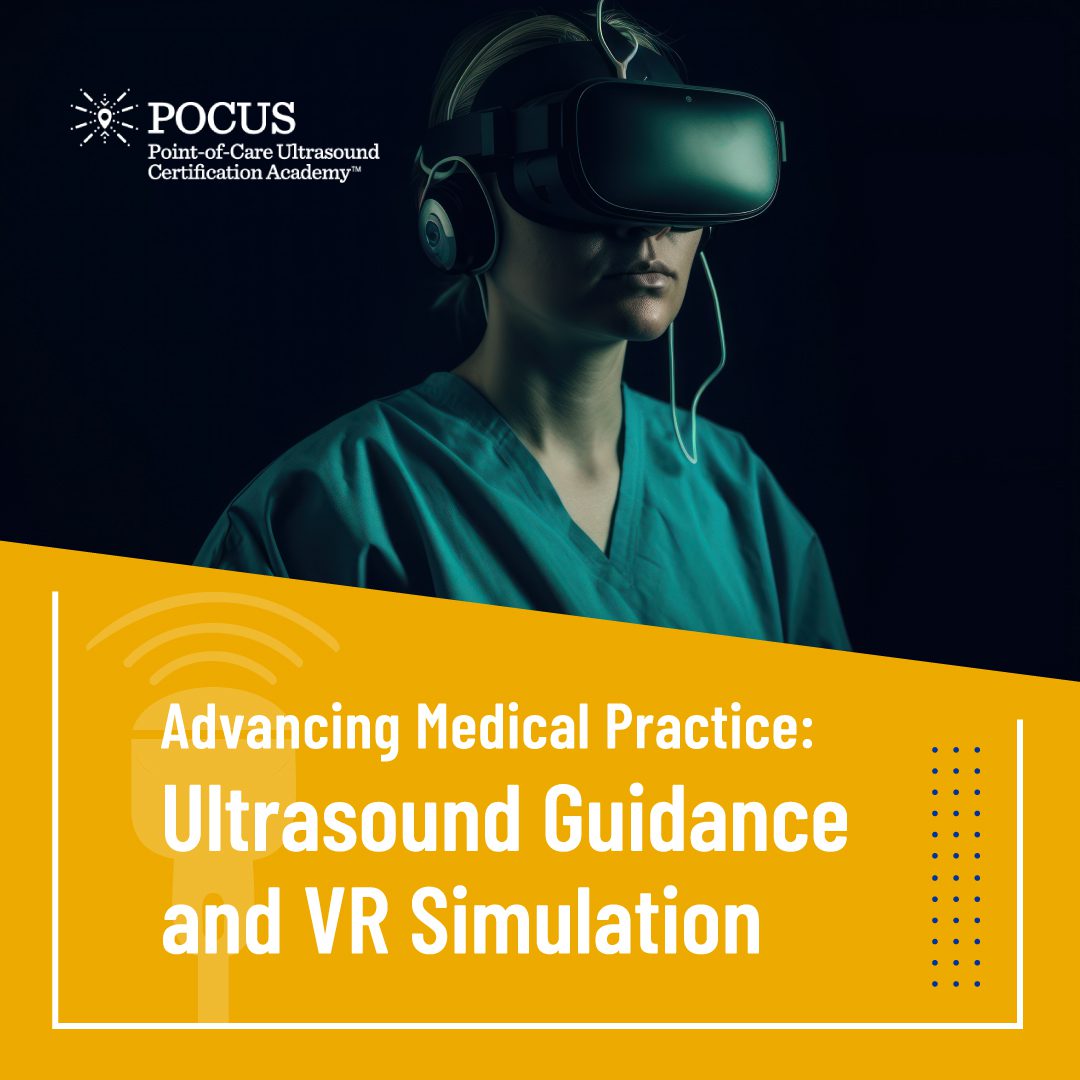
The POCUS Certification Academy
Advancing Medical Practice: Ultrasound Guidance and Virtual Reality Simulation
By Elizabeth Santana, MBA, CAE, CPTD, ICE-CCP and Victor Rao*, MBBS, DMRD, RDMS
Introduction
In the ever-evolving field of medicine, advancements in technology have revolutionized the way procedures are performed, leading to improved patient outcomes and enhanced patient safety. Ultrasound guidance has emerged as a vital tool for invasive procedures, providing real-time imaging and precise visualization of the target tissue and the needle tip. Additionally, the integration of virtual reality (VR) simulation in training programs has shown great promise in teaching healthcare professionals the intricate art of ultrasound-guided procedures. In this blog post, we will explore the significance of ultrasound for procedural guidance and discuss why VR simulation is an invaluable asset for training in this field.
Ultrasound Guidance as a Game-Changer in Procedural Accuracy
Ultrasound technology has significantly transformed the landscape of invasive medical procedures. The revised statement on recommendations for use of real-time ultrasound guidance for the placement of central venous catheters by the American College of Surgeons states that “the use of ultrasound has been associated with a reduction in complication rate and improved first-pass success when placing catheters in the internal jugular vein (IJV) and the subclavian vein (SV)”.1 Ultrasound imaging used during procedures provides clinicians with real-time imaging, allowing for precise visualization of anatomical structures; the region of interest; anatomical structures to avoid; and the needle shaft and tip. This level of accuracy is particularly vital in procedures such as biopsies, aspirations, and intravascular catheter placements. The ability to visualize the target area in real time enables clinicians to navigate with precision, reducing the risks associated with these procedures and the time taken to perform them, while increasing success rates.
The Importance of Virtual Reality Simulation in Training
While the benefits of ultrasound guidance are clear, the proficiency required to perform these procedures is acquired through rigorous training. This is where virtual reality (VR) simulation comes into play. VR offers a safe, controlled, and immersive environment for trainees to practice and perfect their skills before performing the procedure on patients.
Below, we list five reasons why VR simulation is particularly valuable for training clinicians in ultrasound guidance for procedures:
- Realistic Replication
VR simulation can replicate the look and feel of real patients and clinical environments, creating a lifelike experience. Trainees can practice manipulating the ultrasound probe, practice image optimization, develop hand-eye coordination skills, images interpretation, and critical decision making in a controlled setting. This immersive environment helps build confidence and familiarity with the ultrasound equipment.
- Repeatable Practice
VR simulation allows for unlimited repetitions of procedures without the limitations of patient or mannikin availability. Trainees can refine their technique, improve hand-eye coordination, and develop the dexterity required for ultrasound-guided procedures. The ability to repeat complex tasks in a risk-free environment fosters mastery and improves the learning curve.
- Varied Clinical Scenarios
VR simulation can offer a wide range of clinical scenarios, from routine procedures to complex cases. Trainees can encounter normal and variant anatomy, different types of pathology, and challenging situations that they may not encounter frequently during their clinical training. This exposure helps develop adaptability and critical thinking skills necessary for successful procedural guidance. Digital resources can often be repurposed or reused, which also helps control development costs.
- Objective Performance Assessment
VR simulation provides a platform for objective performance assessment. Information can be tracked and collected from numerous data points. Trainees can receive immediate feedback on their technique, accuracy, and decision-making skills. This feedback loop allows for continuous improvement and targeted training interventions to address areas that need further development.
- Cost and Resource Efficiency
VR simulation significantly reduces the reliance on expensive equipment and consumables, making training more accessible and cost-effective. It minimizes the risks associated with learning on real patients and reduces procedure time. Also, affordable VR headsets are gaining in popularity for household use, allowing some trainees to practice in their own homes without having to go to an educational institution or simulation center, optimizing resource utilization in healthcare education settings, improving access, and extending the opportunity for students to refine their skills.
Conclusion
Ultrasound guidance has revolutionized the accuracy and safety of invasive medical procedures, improving patient outcomes across various specialties. Integrating VR simulation in training programs for ultrasound-guided procedures offers numerous advantages, including realistic replication, repeatable practice, exposure to diverse scenarios, objective assessment, and cost efficiency. The combination of ultrasound guidance and VR simulation promises to elevate the skills and proficiency of healthcare professionals, ensuring the delivery of high-quality care and improving patient safety in the years to come.
In collaboration with ChatGPT*
Take our 30-second survey
We want to hear your level of interest in an Ultrasound guidance (USG) certificate for specific procedures offered in virtual reality (VR). Scan the QR code below to take our brief survey.






















